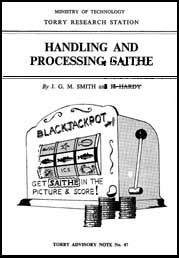Contents Index

Accompanying Notes
Table of Contents
By J. G. M. SMITH and R. HARDY
MINISTRY OF TECHNOLOGY
TORRY RESEARCH STATION
TORRY ADVISORY NOTE No. 47
Crown copyright material is reproduced with the permission of the Controller of Her Majesty's Stationery Office.
This electronic document has been scanned using optical character recognition (OCR) software and careful manual recorrection. Even if the quality of digitalisation is high, the FAO declines all responsibility for any discrepancies that may exist between the present document and its original printed version.
Gives common, scientific and foreign names for saithe and summarises the distinguishing features and life history. In 1998, the UK landings from UK vessels were about 8,500 tonnes, only 18% of the landings in 1965, and the value was £4.9 million, roughly 3 times the value of landings in 1965. Advises on handling whole fish and fillets, emphasises the importance of bleeding, and that poor handling practices lead to a poor quality product. Advises on chilling, freezing and smoking, and gives information on composition. In addition to the other Notes referenced in the text, Notes 31, 34 and 76 are also relevant. It is important to note that the current food legislation should be consulted concerning the permitted use of colours in products, and the labelling of products.
(FAO in partnership with Support unit for International Fisheries and Aquatic Research, SIFAR, 2001).
Introduction
Scientific name
Common names
Foreign names
Distinguishing Features
Size and weight
Life history
Saithe as a food fish
Handling saithe at sea
Handling saithe fillets
Freezing and cold storage
of saithe
The use of saithe in fish
products
Smoked saithe
Smoked seelachs,
or smoked delicatessen saithe
Composition of saithe
Contents Index